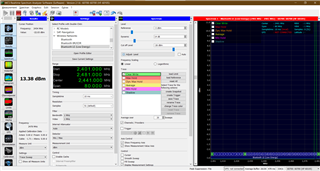Hi everyone.
For FCC testing we are required to create firmware builds to transmit at the beginning, middle, and end of the BLE spectrum to allow the lab to verify duty cycle, output power, etc. I am using the radio test example to accomplish this, having created 3 builds to transmit at (ideally) channels 0,40, and 80. However, I am finding large variations in output power at the fringes of the channel spectrum (channels 0,1, and the late 70's vary significantly with output power). I am measuring all of this with a spectrum analyzer hooked up to the nrf52840 DK via an SMA cable connection. At other channels, such as channel 2 or 39, I am getting normal readings (near 8dBm, as I have set the output power to +8dBm).
Below I have placed some of my observations at select radio channels:
| Channel | Output Power (dBm) |
| 0 | -20.4 |
| 1 |
6.1 |
| 2 |
7.9 |
| 40 | -15.2 |
| 78 | 12.2 |
| 79 | 10.8 |
| 80 |
-13.9 |
I can understand there being discrepencies at the fringes of the spectrum (near channel 0 and 80), but channel 40 having such a low output power does not make sense to me, especially when channels 39 and 41 seemed to work fine. I have tested these using both the radio test example (with the CLI commands) as well as with my own firmware builds.
For FCC testing, I should be fine to use channels 2 and 39 for the beginning and middle of the spectrum, but the end of the spectrum seems to have more issues. I am wondering if anyone could help explain these observations, and also let me know if the high output power seen at the end of the spectrum will be a problem for FCC certification.
Thank you.




